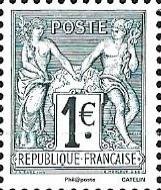Stamp: Stamp type Sage 1876 (France 2016)
Stamp type Sage 1876 (France 2016)
03 November (France ) within release 70th Philatelic Exhibition of Autumn goes into circulation Stamp Stamp type Sage 1876 face value 1 Euro
| Stamp Stamp type Sage 1876 in catalogues | |
|---|---|
| Yvert et Tellier: | Yt: FR 5095 |
| Michel: | Mi: FR 6605II |
Stamp is vertical format.
N of INV under U of REPUBLIQUE Printed only in Mini-sheet of 20 stamps including: - 10 stamps with N of INV under B of REPUBLIQUE - 10 stamps with N of INV under U of REPUBLIQUE. Block issued in reference to the stamps of FRANCE printed between 1876 and 1890 to the type SAGE.Also in the issue 70th Philatelic Exhibition of Autumn:
- Stamp - Stamp type Sage 1876 face value 1;
- Se-tenant - Type Sage face value 1;
Stamp Stamp type Sage 1876 it reflects the thematic directions:
A map is a symbolic depiction emphasizing relationships between elements of some space, such as objects, regions, or themes. Many maps are static, fixed to paper or some other durable medium, while others are dynamic or interactive. Although most commonly used to depict geography, maps may represent any space, real or imagined, without regard to context or scale, such as in brain mapping, DNA mapping, or computer network topology mapping. The space being mapped may be two dimensional, such as the surface of the earth, three dimensional, such as the interior of the earth, or even more abstract spaces of any dimension, such as arise in modeling phenomena having many independent variables. Although the earliest maps known are of the heavens, geographic maps of territory have a very long tradition and exist from ancient times. The word "map" comes from the medieval Latin Mappa mundi, wherein mappa meant napkin or cloth and mundi the world. Thus, "map" became the shortened term referring to a two-dimensional representation of the surface of the world.
A man is an adult male human. Prior to adulthood, a male human is referred to as a boy (a male child or adolescent).
A woman is an adult female human. Before adulthood, a woman is referred to as a girl (a female child or adolescent)



